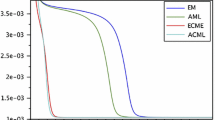Abstract
In this study, we present a new method, called a tensor method, for the computation of unconstrained Full-Information Maximum Likelihood (FIML) estimates. The new techniqus is based upon a fourth order approximation to the log-likelihood function, rather than the second order approximation used in standard methods. The higher order terms are low rank third and fourth order tensors that are computed, at very little storage or computation cost, using information from previous iterations. We form and solve the tensor model, then present test results showing that the tensor method is far more efficient than the standard Newton's method for a wide range of unconstrained FIML estimation problems.
Similar content being viewed by others
References
Chow, T.-T., 1989,Derivative and Secant Tensor Methods for Unconstrained Optimization, Ph. D. thesis, University of Colorado, Computer Science Department.
Dennis, J. E. and Schnabel, R. B.,Numerical Methods for Unconstrained Optimization and Nonlinear Equations, (Prentice-Hall, Englewood Cliffs, New Jersey).
Frank, P. D., 1984,Tensor Methods for Solving, Systems of Nonlinear Equations, Ph. D. thesis, University of Colorado, Computer Science Department.
Greenblatt, S. A., 1993,Tensor Methods for Full-Information Maximum Likelihood Estimation Ph.D. dissertation, George Washington University, Department of Economics.
Haavelmo, T., 1943, The statistical implications of a system of simultaneous equations,Econometrica 11 (1), 1–12.
Koopmans, T. (Ed.), 1950.Statistical Inference in Dynamic Economic Models, Number 10 in Cowles Commission Monograph. (Wiley, New York).
Lucas, Jr, R. E., and Rapping, L.A., 1985, Real wages, employment, and inflation, In R. E. Lucas, Jr (Ed.),Studies in Business-Cycle Theory. (MIT Press, Cambridge, Massachusetts).
Parke, W. R., 1979,An algorithm for Full Information Estimation, Ph. D. thesis, Yale University, Economics Department.
Parke, W. R., 1982, An algorithm for FIML and 3SLS estimation of large nonlinear models,Econometrica 50 (1), 81–95.
Schnabel, R. B. and Chow, T.-T., 1989, Tensor methods for unconstrained optimization using second derivatives, Technical Report CU-CS-439-89, University of Colorado, Computer Science Department.
Schnabel, R. B. and Chow, T.-T., 1991, Tensor methods for unconstrained optimization using second derivatives,SIAM Journal of Optimization,1, (3) 293–315.
Schnabel, R. B. and Frank, P.D. 1984, Tensor methods for nonlinear equations,SIAM Journal of Numerical Analysis 21 (5), 815–843.
Schnabel, R. B. and Frank, P.D. 1986, Solving systems of nonlinear equations by tensor methods, Technical Report CU-CS-334-86, University of Colorado Computer Science Department.
Author information
Authors and Affiliations
Additional information
This paper is based upon part of my doctoral dissertation at George Washington University. I would like to thank my committee members, Professors Robert Phillips and Frederick Joutz of George Washington University and John R. Norsworthy of Renssalaer Polytechnic Institute for their support and suggestions. Any errors remaining are my own.
Rights and permissions
About this article
Cite this article
Greenblatt, S.A. Tensor methods for full-information maximum likelihood estimation: Unconstrained estimation. Comput Econ 7, 89–108 (1994). https://doi.org/10.1007/BF01299569
Accepted:
Issue Date:
DOI: https://doi.org/10.1007/BF01299569




